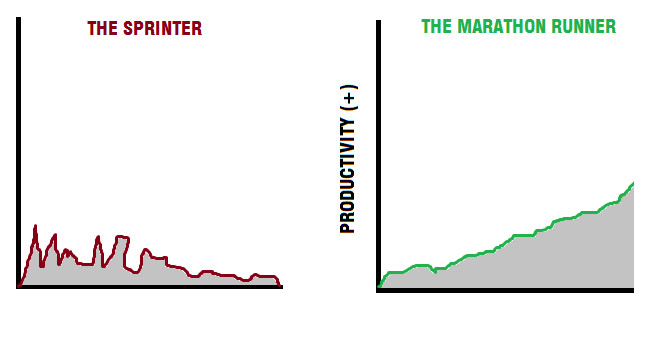Marathon Vs Sprint
Marathon involves long-distance running, while sprint is short, intense bursts of speed. Both types of training offer unique benefits for overall fitness and endurance development.
Marathons test endurance and stamina over extended periods, promoting cardiovascular health and mental toughness. On the other hand, sprints focus on explosive power, muscle strength, and speed improvement in a shorter duration, leading to enhanced calorie burn and muscle definition.
Understanding the differences between marathon and sprint training can help individuals tailor their workout routines to meet their fitness goals effectively. Whether aiming for long-term endurance or quick bursts of power, incorporating a combination of both marathon and sprint workouts can lead to a well-rounded fitness regimen.

Credit: www.sylvina.com
Definition And Purpose
When it comes to software development, two common frameworks used are Agile and Waterfall. Within the Agile framework, there are two main methodologies – sprint and marathon. Understanding the differences between these two approaches is essential for project managers and developers who seek to implement efficient development processes. Let’s delve into the definitions and purposes of marathons and sprints to gain a clear understanding of their roles in software development.
What Is A Marathon?
A marathon in the Agile development context refers to a sustained and continuous development cycle that typically spans over a longer duration, such as several weeks or months. The focus of a marathon is on steady progress and a consistent pace. It involves careful planning and execution to ensure that the development team can maintain momentum over an extended period. The key objective of a marathon is to deliver a fully functional and tested product increment at the end of the specified timeline.
What Is A Sprint?
A sprint is a short, time-boxed iteration within the Agile development framework, usually lasting from one to four weeks. It is characterized by intense, focused work on a set of predefined tasks, aiming to achieve specific, measurable goals within the allocated time frame. Sprints promote rapid development, quick feedback loops, and adaptive adjustments based on customer requirements and changing market conditions. The primary purpose of a sprint is to produce a potentially shippable product increment at the end of the iteration.

Credit: m.youtube.com
Duration And Intensity
When comparing marathon and sprint training, it’s essential to consider the duration and intensity of each. These factors play a significant role in shaping the type of athlete you become and the goals you can achieve.
Long-distance Endurance
- Marathons require sustained effort over an extended period.
- Training focuses on building stamina and endurance.
- Consistent pacing and mental fortitude are crucial.
Short Burst Of High Intensity
- Sprints involve quick bursts of high-intensity activity.
- Explosive power and speed are key components.
- Training emphasizes short, intense workouts.
Training And Preparation
When it comes to marathon vs. sprint training and preparation, there are distinct differences in the approach needed for each.
Endurance Building
Endurance is crucial for marathon runners, requiring consistent long-distance runs at a steady pace.
Interval Training
Interval training is essential for sprinters, focusing on short bursts of intense exercise followed by rest.
Physical Demands
Engaging in marathon running and sprinting both come with distinct sets of physical demands. Understanding these differences can help individuals decide which type of running is best suited for their personal fitness goals and capabilities.
Slow And Steady Pace
A marathon requires endurance and sustained energy over a longer period of time. Runners must maintain a slow and steady pace to cover the extensive distance. This means there is a heavy emphasis on aerobic capacity and muscular endurance rather than explosive power.
Explosive Speed
Sprinting, on the other hand, focuses on explosive speed and power over shorter distances. It demands fast-twitch muscle fibres to generate rapid and forceful movements, placing a greater emphasis on anaerobic capacity and muscular strength. Quick response time and acceleration are crucial in sprinting.
Mental Focus And Strategy
Discover the key to mental focus and strategy in the Marathon vs Sprint debate. Learn how to optimize your performance and achieve your goals with effective tactics tailored to each approach.
Mental focus and strategy play a crucial role in both marathon and sprint races. However, the nature of these two types of races demands different approaches to excel. Let’s dive into the mental attributes required for each and how they contribute to the overall performance.
Pacing And Endurance Management
Pacing and endurance management are vital aspects of marathon running. Unlike sprints, marathons require a more measured and consistent approach to maintain stamina throughout the race. Runners need to create a race plan that focuses on energy conservation to avoid burnout and finish strong.
In a marathon, it’s important to resist the temptation to start at a sprinting pace, as this can exhaust the body before the halfway point. Optimal pacing involves maintaining a steady speed that allows for endurance and a consistent rhythm. This involves finding a balance between pushing oneself and conserving energy for crucial moments during the race.
Endurance management is also key in marathon running. Runners must train their bodies to withstand the physical demands of running for an extended period. Mental fortitude comes into play as runners navigate through moments of fatigue and the temptation to slow down or give up.
Quick Decision-making And Agility
While marathon runners require pacing and endurance, sprinters rely on quick decision-making and agility. In sprint races, every split-second decision can make a significant difference in the outcome.
Sprinters must react swiftly to the starting gun and explosively accelerate, propelling themselves towards the finish line. Their mental focus requires a sharp understanding of their body’s capabilities and limitations.
During sprints, agility plays a vital role. Sprinters must be mentally prepared to make split-second adjustments in technique or stride length to optimize their performance. This level of agility enables sprinters to adapt to changing conditions on the track and maintain their speed effectively.

Credit: www.fitmole.org
Frequently Asked Questions Of Marathon Vs Sprint
How Do Sprints Benefit In Project Management?
Sprints in project management allow for incremental progress, focused collaboration, and efficient delivery of high-quality results.
What Are The Advantages Of Marathon Work Style?
Marathon work style ensures sustained performance, improved productivity, and the ability to handle complex tasks with greater attention to detail.
How Do Marathons And Sprints Differ In Achieving Goals?
While marathons prioritize long-term planning and endurance to achieve sustainable goals, sprints emphasize short bursts of focused effort to achieve quick wins and meet deadlines.
Conclusion
In the race of productivity, both marathon and sprint work styles have their merits. Understanding your work rhythm and the demands of your tasks is key to finding the right balance. By recognizing when to push for long-term endurance or short bursts of energy, your productivity can soar.
Experiment, find what suits you best, and thrive!







